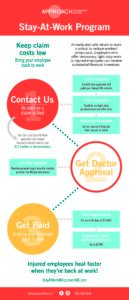
Nine Ways to Earn Thousands with Washington Stay-At-Work
After an employee is injured on the job, the best outcome is for he or she to get back to work as quickly as possible. That’s why Washington state will actually pay half of the employee’s wages while they are on an approved light duty assignment. It’s called Washington Stay-At-Work (WSAW, or just SAW) and it can mean thousands of dollars for your company.
Put simply, SAW will reimburse half of the employee’s wages, up to $10,000 or 66 days of light-duty work, plus $3,900 for related expenses. If you’re thinking, “we don’t have any light-duty at our shop,” then read on to find out how Approach helps clients to create light-duty work and earn this money back from SAW:

1. Start planning before a workplace injury occurs
Of course, the best case is that no worker is ever injured on the job. We offer free safety visits to help make this goal a reality for your company. You should also have an Injured Worker Packet at the ready in case an accident does take place. Ask your Approach Retro Coordinator for a copy or download it from our Client Portal.
2. Don’t just let time-loss payments start up
If an accident does occur, it’s easy to assume that an injured worker just goes home to recover and that the state will cover their time-loss. Don’t do this! Time-loss payments are charged to your company’s workers comp account, so just like car insurance, it will affect your rates for years to come. SAW helps lower your costs instead.
3. Get an Activity Prescription Form (APF) from the doctor
Your injured employee should see a doctor right away. In turn, the doctor should provide APF that outlines any work limitations as a result of the injury. Use this information to create a temporary light-duty position that conforms to any restrictions. We’ll provide you with templates to get you started, plus expert advice in tailoring a job to specific requirements.
4. A doctor’s approval is vital
The light-duty work must be within any work restrictions outlined on the Activity Prescription Form (APF) and you must request approval from the doctor. Luckily, reimbursements can start from the day you request approval (by faxing the job description to the doctor), so work can begin even if you haven’t heard back yet. It may seem simple, but let’s take a look at #5), below.

5. Remember, the #1 reason Stay-At-Work applications are rejected is…
…failing to submit the job description for doctor’s approval. You must keep a record of the date that the job description was transmitted or hand delivered to the doctor. This date is the first one for which you can claim SAW refunds.
6. Keep good records
We’ll need time cards and pay stubs (or payroll earning statements) to claim your SAW rebates. The time cards must show the date and the number of light duty hours worked, while payroll information needs to show the gross pay received while on light-duty.

7. Only request reimbursement for actual light-duty work
When tallying up to 66 days or $10,000 in light-duty wages, remember that the hours/wages must be for work performed while on a light-duty assignment. Don’t include pay for any of the following, even if they were during a light-duty assignment, as they won’t be eligible for reimbursement:
- Sick/vacation/PTO days
- Kept on Salary
- Time off for medical or physical therapy appointments
- Holidays, unless the worker performed light-duty work on the holiday
Again, these wages can’t be reimbursed under SAW because no work was performed and you’re not required to pay wages for those days.
8. Keep records for equipment purchases as well
Remember the almost $4,000 for equipment? This doesn’t need to be specialized equipment, it just needs to be something your employee needs to be successful in their light-duty position. Let’s say you have a field employee who needs to work in the office for a while. The clothing they wear and they desk they sit at can be reimbursed if they are new expenses for your company. Even a new software license can be reimbursed if the employee is working on a new project. We’ve helped claim reimbursements for shredders, scanners, and other office equipment you might not even think of!
9. Don’t give up!
According to our stay-at-work specialist, the biggest surprise of the SAW program is that it really does work. It takes time and effort to create a light-duty position for your employee, but think of the impact a check for $10,000 or more can have on your business!

Recap checklist for successful Stay-At-Work reimbursement:
- Light-duty job description (approved & signed by medical provider and employee)
- Daily time sheets
- Paystubs (or payroll earnings statement)
- Stay-At-Work reimbursement application
Contact us as soon as a workplace injury or claim occurs, so we can help you get organized, complete the paperwork, and get on the path to Stay-At-Work right away.
